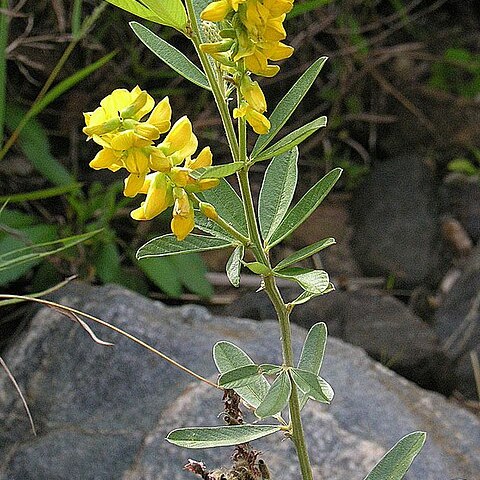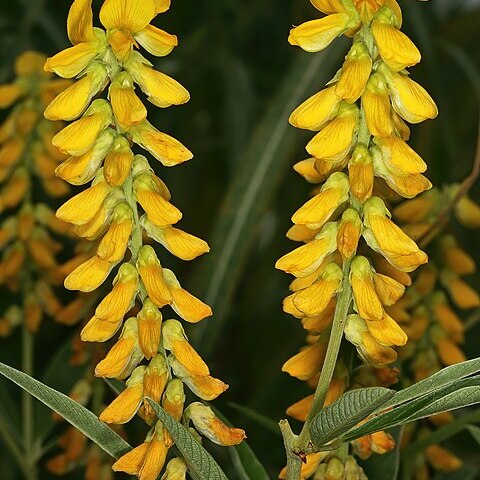Erect, branched subshrub or woody herb, 0·75–2·4(–3·6) m. tall.. Branches strongly ribbed, shortly densely brownish hairy, often ± velvety and covered with small orange-red glands.. Leaflets 3, paler beneath, narrowly elliptic, elliptic-oblong or obovate-elliptic, 2·3–9·5 cm. long, 0·8–3·5(–4) cm. wide, rounded and mueronulate, emarginate or rarely acute at the apex, cuneate, finely to densely velvety pubescent above, velvety beneath, the venation prominent and usually with buff hairs, the rest of the leaflet surface with silvery or ferruginous tomentum or slightly coarser indumentum; petiole 1–5 mm. long; rhachis 1–8 mm. long; petiolules 1–3 mm. long.. Racemes many-flowered, terminal and axillary; rhachis (2–)6–12 cm. long; peduncle 1–3 cm. long; pedicels 2 mm. long.. Calyx adpressed pilose or pubescent, usually glandular, 3·5–7 mm. long; lobes triangular or narrowly triangular, equalling the tube.. Corolla deep golden-yellow; standard obovate, 0·7–1·4 cm. long, glabrous or rarely with a few hairs outside, glandular; keel paler yellow, glandular.. Pods suborbicular, oval or oval-oblong, often oblique, 1·1–1·8 cm. long, 0·9–1·1 cm. wide, covered with long ferruginous hairs.. Seeds dark reddish-brown or pinkish buff with blue-black mottling, shiny, longest dimension 4·5–5·2 mm., shorter dimension 2·5–3·5 mm., 1–1·5 mm. thick; rim-aril creamy brown.
Erect, branched subshrub or woody herb, 0.75-2.4(3.6) m tall. Branches strongly ribbed, shortly densely brownish hairy, often ± velvety and covered with small orange-red glands. Leaflets 3 or occasionally some lower leaves 1-foliolate, paler beneath, 2.3-9.5 x 0.8-3.5(4) cm, narrowly elliptic, elliptic-oblong or obovate-elliptic, rounded and mucronulate, emarginate or rarely acute at the apex, cuneate, finely to densely velvety pubescent above, velvety beneath, the venation prominent and usually with buff hairs, the rest of the leaflet surface with silvery or ferruginous tomentum or slightly coarser indumentum; petiole 1-5 mm long; rhachis 1-8 mm long; petiolules 1-3 mm long. Racemes many-flowered, terminal and axillary; rhachis (2)6-12 cm long; peduncle 1-3 cm long; pedicels 2 mm long. Calyx appressed pilose or pubescent, usually glandular, 3.5-7 mm long; lobes triangular or narrowly triangular, equalling the tube. Corolla deep golden-yellow; standard 7-14 mm long, obovate, glabrous or rarely with a few hairs outside, glandular; keel paler yellow, glandular. Pods 1.1-1.8 x 0.9-1.1 cm, subcircular, ovate or elliptic-oblong, often oblique, covered with long ferruginous hairs. Seeds dark reddish-brown or pinkish-buff with blue-black mottling, shiny, 4.5-5.2 x 2.5-3.5 x 1-1.5 mm; rim aril creamy-brown.
Leaflets 3 or occasionally some lower leaves 1-foliolate, paler beneath, 2.3–9.5 × 0.8–3.5(4) cm, narrowly elliptic, elliptic-oblong or obovate-elliptic, rounded and mucronulate, emarginate or rarely acute at the apex, cuneate, finely to densely velvety pubescent above, velvety beneath, the venation prominent and usually with buff hairs, the rest of the leaflet surface with silvery or ferruginous tomentum or slightly coarser indumentum; petiole 1–5 mm long; rhachis 1–8 mm long; petiolules 1–3 mm long.
A herb or shrub. It is tall and erect. It can be 2 m tall. There are dense grey hairs on the stems and under the leaves. The leaves have 3 leaflets. These are sword shaped and 6 cm long by 1.2 cm wide. They have a small tip. There are many flowers. These are close together on short flower shoots. They are yellow. The fruit are rough pods. They are 1.5 cm long by 8 mm wide.
Corolla deep golden-yellow; standard 7–14 mm long, obovate, glabrous or rarely with a few hairs outside, glandular; keel paler yellow, glandular.
Calyx appressed pilose or pubescent, usually glandular, 3.5–7 mm long; lobes triangular or narrowly triangular, equalling the tube.
Seeds dark reddish-brown or pinkish-buff with blue-black mottling, shiny, 4.5–5.2 × 2.5–3.5 × 1–1.5 mm; rim aril creamy-brown.
Pods 1.1–1.8 × 0.9–1.1 cm, subcircular, ovate or elliptic-oblong, often oblique, covered with long ferruginous hairs.
Branches strongly ribbed, shortly densely brownish hairy, often ± velvety and covered with small orange-red glands.
Racemes many-flowered, terminal and axillary; rhachis (2)6–12 cm long; peduncle 1–3 cm long; pedicels 2 mm long.
Erect, branched subshrub or woody herb, 0.75–2.4(3.6) m tall.


